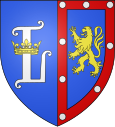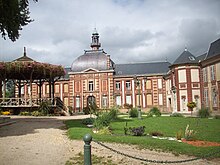Louviers
| Louviers | ||
|---|---|---|

|
|
|
| region | Normandy | |
| Department | Your | |
| Arrondissement | Les Andelys | |
| Canton | Louviers (main town) | |
| Community association | His-yours | |
| Coordinates | 49 ° 13 ′ N , 1 ° 10 ′ E | |
| height | 11-149 m | |
| surface | 27.06 km 2 | |
| Residents | 18,648 (January 1, 2017) | |
| Population density | 689 inhabitants / km 2 | |
| Post Code | 27400 | |
| INSEE code | 27375 | |
| Website | http://www.ville-louviers.fr/ | |
 Louviers Town Hall |
||
Louviers is a French city with 18,648 inhabitants (at January 1, 2017) in the Eure in the region of Normandy . It belongs to the Arrondissement of Les Andelys and is the capital of the canton of Louviers .
geography
Louviers is located on the banks of the Eure River , only about four kilometers west of the Seine loops in the east of the large forest Forêt domaniale de Bord-Louviers (also known as Forêt de Louviers or Forêt de Bord ), 25 kilometers southeast of Rouen and two kilometers south of Incarville .
history
In the 9th century Louviers was mentioned in a document as Locos veteres , in the annals of the Abbey of Saint-Bertin it appears in the 10th century as Loviers and in the 11th century as Lotvers . According to Beaurepaire, the Latin place names Locos veteres ('old place') or Locus veris ('place of spring') were wrongly translated back by clergy writers. Because in other place names the Latin word locus has developed into the French word lieu . Endings in -viers are typical for northern France and Belgium , according to Beaurepaire ( e.g. Reviers , Verviers ). He assumes that -viers developed from the Proto-Indo- European word var or ver for 'water'.
On February 10, 856, King Louis the Stammler celebrated the engagement of his son Ludwig to a daughter of Erispoë, the Duke of Bretons, in Louviers .
The city was besieged in the Hundred Years War (1337-1453). In 1442, King Charles VII gave her the name Louviers-le-Franc (roughly 'the free Louviers').
In 1793 Louviers received in the course of the French Revolution (1789-1799) the status of a municipality and 1801 the right to local self-government .
During the Second World War , Louviers was bombed by the Luftwaffe on June 9 and 10, 1940 . The water and electricity supply as well as the telephone lines were interrupted. On June 11, the city was almost completely evacuated. On the night of June 11th to June 12th, an artillery battle between the advancing Wehrmacht and the 25e régiment d'artillerie took place in Louviers , which destroyed the old town in the city center. The next day, German troops occupied Louviers.
In the summer of 1944, the Allied Air Force bombed the city as part of Operation Overlord .
| year | 1793 | 1800 | 1806 | 1866 | 1921 | 1946 | 1954 | 1962 | 1968 | 1975 | 1982 | 2007 |
|---|---|---|---|---|---|---|---|---|---|---|---|---|
| Residents | 9,520 | 6,819 | 8,472 | 11,707 | 10,345 | 9,624 | 10,746 | 13,160 | 15,326 | 18,333 | 19,000 | 18.102 |
The population of Louviers increased from 6,819 in 1800 to 19,000 in 1982. The increase was particularly large in the second half of the 20th century.
Town twinning
Louviers has twinned with Weymouth and Portland (since 1959), with Holzwickede (since 1978) and with San Vito dei Normanni (since 2005).
Culture and sights
Green spaces
Louviers is represented with three flowers in the Conseil national des villes et villages fleuris (National Council of Flowered Cities and Villages). The "flowers" are awarded in the course of a regional competition, whereby a maximum of three flowers can be achieved.
The city park Aristide-Briand was opened on Pentecost Sunday 1927. It was designed by the director of the public parks of Rouen and planted with tall trees such as silver linden , a ginkgo , a funeral cord tree and a giant sequoia tree . In December 1999, the trees in the park were damaged or even felled by Hurricane Lothar , and they were replaced by Chilean araucarias , sequoias, Hungarian oaks , common ash trees and antler trees , among others . The park's winding avenues are 1200 meters long. The park also offers classic carpet beds , exotic date and dwarf palms, as well as vegetables and cacti .
Delos Park is opposite the hospital . It also belongs to the city and is home to a ginkgo, a milk orange tree , a tulip tree and a large bald cypress , whose roots hang in the Eure that borders the park. The actual park of the hospital was redesigned in 1977. Its large banana trees , a eucalyptus , butterbur and stilted reed give it an exotic character today.
Le Jardin de Saint-Lubin park was established in 1870. It is named after the saint and bishop Leobinus of Chartres († around 557). The park features Corsican black pines , coastal redwoods , black nuts and Atlas cedars .
The town hall garden was set up in 1987 around a pavilion from 1907. Several buildings used to stand where the garden is today, including the Saint-Louis convent and its church.
Buildings
The Saint-Louis Convent was built from 1625. The convent included a church consecrated in 1645, a hospital that was enlarged in 1726, and a cloister . In 1702 the residential buildings were extended to the east. In 1791 the church was converted into a court during the French Revolution, and in 1899 it was finally destroyed. In 1796 the Mairie ("Town Hall") moved to the hospital. In 1846 the cloister was destroyed.
The Notre-Dame-de-Consolation monastery of the " Community of the 3rd Order of Penitents " (Pénitents) of the Franciscan Order was founded in 1646. The monastery was closed during the French Revolution and from 1803 to 1928 the buildings were used as dungeons . Grain was stored in the church of the monastery until 1828, when the building was destroyed. The northern part of the cloister was destroyed in 1910 when the rue de Pénitents ("street of penitents") was expanded. Nevertheless, the cloister is still a unique building today, because the Eure flows through it. The surviving buildings have housed the music school since the 1980s.
Notre-Dame Church was built in the 13th century and classified as a Monument historique ('historical monument') in 1846 .
- Maison du Parlement (16th century), alternative meeting place for the Parlement de Rouen during the Huguenot Wars
- 16th century streets with half-timbered houses ( Monument historique )
- Manoir de Bigards (16th - 17th centuries)
- Musée des décors de Théâtre, d'Opéra et de Cinéma
Economy and Infrastructure
In 1803, the first wool spinning mill in France was built here to use hydraulic energy.
Protected Geographical Indications (IGP) apply to pork (Porc de Normandie) , poultry (Volailles de Normandie) and cider (Cidre de Normandie and Cidre normand) in the municipality .
Louviers is classified as Ville Internet with an @ . The “@s” are awarded to cities that promote the expansion and use of the Internet, with a maximum of five @s being awarded.
The European route 5 runs between Le Vaudreuil and Incarville, here called the Autoroute de Normandie , it connects Évreux and Rouen. Louviers is connected to the European route by route nationale 154 .
Personalities
sons and daughters of the town
- Jacques François Édouard Hervieux (1818–1905), medic
- Joseph Roger Jourdain (1845-1918), painter
- Georges Gillet (1854–1920), oboist, music teacher and composer
- Maurice Duruflé (1902–1986), composer and organist
- Raymond Reding (1920–1999), comic book artist
- Liza Harper (* 1976), porn actress and partner of Rod Fontana
Personalities who have worked on site
- Jules Develle (1845–1919), politician during the Third Republic . From 1872 to 1876 he was sub-prefect at Louviers.
- Pierre Mendès France (1907-1982), was politician and mayor ( Maire ) of Louviers from 1935 to 1939 and 1953 to 1958.
- François Loncle (* 1941), politician who has been a member of the National Assembly since 1997 . He was also Deputy Mayor of Louviers from 1995 to 2001 and on the Louviers City Council from 2001 to 2008. He is a member of the Parti socialiste .
- Olivier Besancenot (* 1974), politician and founding member of the Nouveau Parti Anticapitaliste . He grew up in Louviers.
literature
- Louis Béquet: L'histoire de Louviers évoquée par les choses . 1978.
- Robert Dauphin: Louviers, 4 années d'occupation 1940–1944 . 1981.
- Jean-Michel Chaplain: La chambre des tisseurs. Louviers, cité drapière (1680-1840) . 1984, ISBN 2-903528-40-3 .
- Dauphin et Marinier: Les rues de Louviers vous parlent ... 1986.
- Abbé Delamare, curé d'Incarville: Histoire des rues de Louviers .
- Yvette Petit-Decroix et al. a .: Les moulins à eau du Pays de Louviers . Société d'Etudes Diverses de Louviers et sa Région.
Web links
Individual evidence
- ↑ Ville de Louviers. In: Actuacity.com. Retrieved June 23, 2010 (French).
- ^ François de Beaurepaire (préf. Marcel Baudot), Les Noms des communes et anciennes paroisses de l'Eure , Paris, A. et J. Picard, 1981, 221 p. ( ISBN 2-7084-0067-3 ) (OCLC 9675154). P. 137.
- ↑ Beaurepaire p. 137
- ↑ a b List of the municipalities of Eure. (No longer available online.) In: eure.pref.gouv.fr. Préfecture of Eure, archived from the original on April 27, 2013 ; Retrieved on August 14, 2011 (French). Info: The archive link was inserted automatically and has not yet been checked. Please check the original and archive link according to the instructions and then remove this notice.
- ↑ a b c A.-V. de Walle: Évreux et l'Eure pendant la guerre . Charles Herissey, Évreux 2000, ISBN 2-914417-05-5 , pp. 29–31 + 34 + 176 (first published in 1946, French).
- ^ Louviers - notice communal. In: Cassini.ehess.fr. Retrieved July 29, 2010 (French).
- ↑ Palmarès des villes et villages fleuris. (No longer available online.) Conseil National des Villes et Villages Fleuris, formerly the original ; Retrieved on August 14, 2011 (French). ( Page no longer available , search in web archives ) Info: The link was automatically marked as defective. Please check the link according to the instructions and then remove this notice.
- ^ A b A. Blanchard, M. Delafenêtre, Lisa Pascual: Jardins en Normandie . Your. Connaissance des Jardins, Caen 2001, ISBN 2-912454-07-7 , pp. 48-56 . (French)
- ↑ Louviers. In: Base Mérimée. Ministère de la culture, accessed July 29, 2010 (French).
- ↑ Entry No. 27375 in the Base Mérimée of the French Ministry of Culture (French)
- ↑ La ville de Louviers. In: Annuaire-Mairie.fr. Retrieved July 21, 2012 (French).
- ^ Louviers @ 2010. Villes Internet, association loi 1901, accessed on July 21, 2012 (French).
- ↑ François Loncle. In: Assemblée nationale. Retrieved June 23, 2010 (French).




